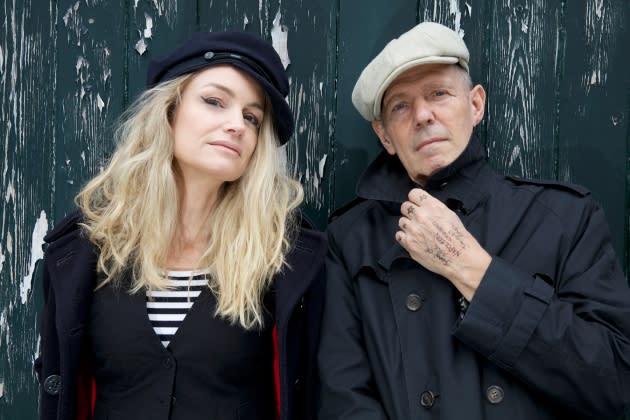How Punk Legend Paul Simonon Channeled Del Shannon and Oscar Wilde on New Song
- Oops!Something went wrong.Please try again later.
- Oops!Something went wrong.Please try again later.
- Oops!Something went wrong.Please try again later.
- Oops!Something went wrong.Please try again later.

Decades ago, “when the Clash was falling apart” – as the band’s bassist Paul Simonon tells it – Joe Strummer wanted to return to his roots busking in public. So he and the band journeyed to the north of England to play in the streets. “We slept on a lot of people’s sofas, because we left our credit cards and money behind and lived on what we earned in the street,” Simonon remembers on a Zoom from his home in London. “We had enough to get to the next town and something to eat.”
A couple of years ago, the bassist decided to try busking again, this time alone and around Palma in Mallorca, Spain, near where he spent much of the pandemic lockdowns. Playing live with a rebel spirit led to writing songs that he ultimately decided to share with his longtime friend, singer-songwriter Galen Ayers, the daughter of the late singer-songwriter and Soft Machine bassist Kevin Ayers.
More from Rolling Stone
Song You Need To Know: The Good, the Bad & the Queen, 'The Truce of Twilight'
Damon Albarn's The Good, the Bad and the Queen Perform 'The Truce of Twilight' in New Video
The Good, the Bad & the Queen Talk Brexit: 'We're Living in Two Different Countries'
“We met years prior and shared a passion for music, and we just got on as people,” Ayers says, Zooming in from her home in Hydra, Greece. “We’ve known each other on and off probably a decade. I bumped into Paul a bunch of times when I grew up in Deia [Spain] and we have a lot of friends in common.” The two artists found they had a natural rapport – a sense of adventure and shared loves of reggae and whimsy – that led to the creation of an album, Can We Do Tomorrow Another Day?, which is credited to Galen and Paul and slated to come out May 19.
A new single from the album, “Room at the Top,” showcases their mutual love of Del Shannon’s keyboard sound, Chopin melodies, and scary movies, as well as their natural vocal harmonies as they sing about ascending a shadowy staircase past a veiled painting. “The voices in my head whisper in my ear,” they sing together, as beach-rock rhythms and Shannon-esque keys support them. “The painting of the dead man won’t release my soul.” The song’s video, shot at Simonon’s place on an iPhone, shows a veiled woman climbing stairs, her hand inching up the railing like a spider.
The story behind the song, though, isn’t nearly as ominous. “It’s sort of a tribute to Del Shannon,” Simonon says. “I was asking Dan Donovan, who plays keyboard on that song, about the keyboard sound in Del Shannon songs. And he went to investigate and found out that it was a one-off instrument. And I said, ‘Well, if you can get something like that sound, then we’ll write a song for it.’ I’ve always loved Del Shannon songs like ‘Hats Off to Larry’; they remind me of a kid when you go to the funfair and there’d be like roller coasters and stuff swinging around. So Dan got a sound, and I thought, ‘We better write a song.’ So it came partly from inspiration and various English Gothic films.”
For the lyrics, Galen and Paul took inspiration from the 1945 film adaptation of The Picture of Dorian Gray, which starred Hurd Hatfield. “He plays a certain melody, it sort of holds the film, and that was also an inspiration,” Simonon says. “In a way, what it’s saying is that we are heaven and hell.”
For as heady as that sounds, what mattered most to Galen and Paul when writing was simplicity. “You have to be able to grab one instrument, preferably the guitar, and just sing it,” Ayers says, “and the dynamics, and the structure is exciting without having to add all the bells and whistles that you can do afterwards to enhance it.”
The song reflects the focus with which they wrote the entire album, holed up in Simonon’s house. “Galen moved into my place – she’s got her own separate floor – and every evening we just sat down and throw ideas across the table,” he says. “I don’t have a TV, so we just stare at each other and play guitar.”
“It’s funny how the music is so chill, because making the record was – what did you say, Paul? – it was like everything was hanging on the wire,” Ayers says of the album, recorded over 15 days. “Everyone was too cool to think it was the worst-case scenario. Everybody wanted to make it work, and so we did.”
Best of Rolling Stone
